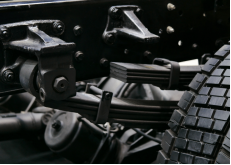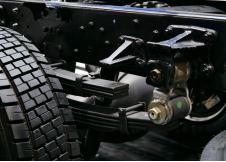Learn more about leaf springs, how to install them and how to choose them.
Not all car/van/truck parts are the same, that much is clear. Some parts are more complex than others and some parts are harder to come by. Every part has a different job to assist in the performance and functionality of the vehicle, so as a vehicle owner it’s important to have a basic understanding of the parts involved.
“Leaf Springs can improve suspensions weighted down with heavy loads”
Things can sometimes get confusing when it comes to learning the different auto parts out there, especially for someone with little experience. A lot of parts are fiddly or confusing and there are so many to choose from – it’s difficult to know where to start. A wise idea is to call someone that knows what they are talking about first before making any rash decisions or to take your motor to a local garage and ask for advice.
Most garages will charge for both parts and labour, so things can get a little expensive when parts need replacing. However, if you acquire the parts yourself, you will often find that you can save yourself a small fortune, so it’s worth doing your research first…
A Beginners Guide to Leaf Springs
Many towers use leaf springs to stabilise their towed load and to keep all cargo on the ground. Although you may not have heard of or noticed them before, leaf spring technology has been around for centuries and is one of the earliest forms of suspension.
How they work?
When the cargo weight or a vehicle is too high, a couple of things can happen. Your vehicle/trailer may start to bounce more or it might start to sway from side to side. If this is the case, and there’s too much weight for the towed vehicle to handle, there might be a problem with the suspension.
If the suspension is too rigid, wheels will sometimes leave the pavement when it hits bumps in the road. Soft suspension may cause the truck to bounce or sway.
Good suspension however will ensure the wheels remain grounded as much as possible. Leaf springs are a great way to keep towed loads stable and to make sure cargo remains on the ground.
How to choose the right leaf spring?
If you compare leaf springs to some other auto parts out there, they really aren’t that fancy. Long and narrow plates are fixed together and attached above/below the axle of a trailer, van or truck to improve the suspension. Too look at, leaf springs are slightly curved (similar to a bow from an archery set, but without the string).
Leaf springs come in a range of sizes and styles to suit diverse needs and different motors. For example, a Mercedes Sprinter leaf spring will differ to that of a Mitsubishi L200 leaf spring, as will a Ford Transit leaf spring and an Ifor Williams leaf spring, just to name a few.
Single-leaf springs (AKA mono-leaf springs) and multi-leaf springs are generally the two options out there, the difference being mono-leaf springs have one plate of spring steel and multi-leaf springs have two or more. Mono-leaf springs consists of several steel plates of varying length stacked on top of each other, with the shortest leaf spring at the bottom. This will give it the same semi-elliptical shape as a single leaf spring but with added thickness in the middle.
When it comes to choosing the right leaf spring, the ends also need to be considered. Depending on where the spring needs to connect to the frame will depend on what type you require. Double-eye springs will have both ends curved into a circle on the longest (top) plate. This creates two holes which can be bolted to the bottom of the van/trailer/truck frame.
Open-eye leaf springs, on the other hand, only have one “eye” or hole. The other end of the spring will usually have a flat end or a hook end.
The correct research will ensure you get your hands on the right leaf spring to suit your needs. Please bare in mind however, the installation of the leaf spring will also have an enormous impact on the suspension and how it performs. Proper installation will ensure the best suspension, but how are leaf springs installed?
How to install leaf springs?
Step 1: Preparation – Before you set about installing your leaf spring, you will need to prepare your old suspension. It’s recommended that you begin this preparation at least 3 days before the old springs are due to be removed. Old leaves may be rusted on so you will need to make sure they are removed without damaging any of the other parts. To prepare the old suspension, soak all existing parts in oil to loosen them up (brackets, nuts and bolt). This will make it easier for you to remove them.
Step 2: Raise Vehicle – Once you have finished preparation, you will need to raise the rear end of the vehicle and remove the rear tyres. You can use a floor jack to do this until the tyres are at least 3 inches off the floor.
Place a jack stand on either side of the vehicle approximately one foot in front of each rear tyre. Then lower the floor jack and use it to support the rear axle by placing it under the rear axle gear housing.
Step 3: Remove Springs – The next step involves removing the old leaf springs. Loosen the prepared nuts and bolts on the bracket U-bolts first, before removing the U-bolts themselves. After you have done this you can remove the leaf springs by removing the eyelet bolts from the bushes. The old leaf spring can now be lowered safely.
Step 4: Attach Eye Bolts – Once you have taken the old springs down, you can put the new ones up. Place the leaf spring in position and the insert the eye bolts and retainer nuts at each end to secure the spring to the hangers. If you can use new nuts and bolts at this point, it is advised.
Step 5: Attach U-Bolts – Tighten all mounting bolts and place the U-bolt brackets around the leaf spring rear axle. Be sure to check that these are secured firmly in place and that all bolts have been tightened properly. It’s recommended to check the tightness of these about a week after installation (assuming the vehicle has been driven), to make sure they haven’t loosened in any way.
Step 6: Lower Vehicle – Remove the floor jacks and lower the vehicle to the ground slowly. Your job is now complete!
Post time: Nov-24-2023








